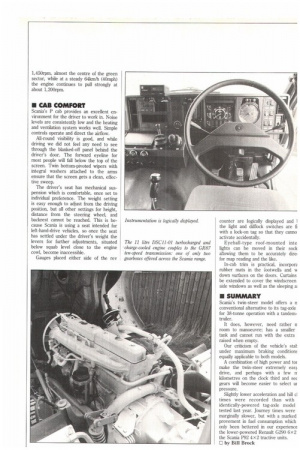ROADTEST
Page 46

Page 47

If you've noticed an error in this article please click here to report it so we can fix it.
SCANIA P112
the bias of braking effort to the front axle. then perhaps it should specify its anti-lock system as soon as it becomes available later this year.
Using much lower pedal effort under normal road going conditions the braking system responded well enough without incident. The exhaust brake is very effective, obviating the need for the service system on many long downhill gradients.
Independent trailer braking — the 'dead man', as it was known — went out of use with the overall improvement in braking standards in 1968. Now Scania has resurrected the idea with a modified version that allows isolated application under restricted pressure. The pressure needs to be limited, for just as a tractive unit will rotate if its rear axles are the first to lock, so will the back of the trailer swing out if its wheels lock up on their own.
It may be that the system could be of some benefit when decending some steep Alpine pass, but its value is hard to evaluate for UK operation.
Should it be needed, its stubby control lever is mounted conveniently alongside the park brake lever which operates spring brake actuators on the two rear axles of the tractive unit. Don't grab the wrong one.
Both levers are located on the relatively high engine cowl in front of the fascia, along with the engine idle control and engine stop button which are both within easy reach.
• TRANSMISSION
With less than 20,000km on the clock we might have expected the gear shift to be stiff, but for the most part the synchromesh range-change box was simplicity itself. Double declutching, a natural habit among those who drive a variety of vehicles, should be avoided: in this case it only wastes fuel. When hurried, as when climbing the slowest and steepest part of a hill, second and third ratios proved difficult to engage. Consequently the vehicle came to a standstill on occasion and it was here that the extra traction was needed to restart.
Rearward movement of the gear lever brings the driver's elbow into conflict with the bunk bar unless care is taken. The foot pedals are a good size and the clutch effort, at 15.5kg, is pleasantly light.
On all but the steeper gradients sixth gear was found to be the one that would hang on; but on long climbs, up Strap for example, the combination of high power and torque maintained vehicle momentum so that we needed only to change down to ninth gear.
Any disadvantages of the twin-steer such as its larger turning circle — only noticeable at the Shotley bridge hairpin — or a 7% smaller fuel tank — not noticed at all — are outweighed by the improvement in normal directional stability and the excellent ride. As is often the case with 6x2+2 articulated combinations, this twin-steer also rolls along very freely: other axle configurations tend to scrub off road speed through the bends and even on the straights.
• PERFORMANCE
A shallow torque curve gives nearmaximum torque from about 1,000rprn to 1,800rpm, so for most of the time the engine can be operated in its most efficient range. In top gear 97km/h (60mph) is maintained at about 1,700rpm and at 80km/h (50mph) engine speed drops to 1,450rpm, almost the centre of the green sector, while at a steady 64Icm/h (40mph) the engine continues to pull strongly at about 1,200rpm.
• CAB COMFORT
Scania's P cab provides an excellent environment for the driver to work in. Noise levels are consistently low and the heating and ventilation system works well. Simple controls operate and direct the airflow.
All-round visibility is good, and while driving we did not feel any need to see through the blanked-off panel behind the driver's door. The forward eyeline for most people will fall below the top of the screen. Twin bottom-pivoted wipers with integral washers attached to the arms ensure that the screen gets a clean, effective sweep.
The driver's seat has mechanical suspension which is comfortable, once set to individual preference. The weight setting is easy enough to adjust from the driving position, but all other settings for height, distance from the steering wheel, and backrest cannot be reached. This is because Scania is using a seat intended for left-hand-drive vehicles, so once the seat has settled under the driver's weight the levers for further adjustments, situated below squab level close to the engine cowl, become inaccessible.
Gauges placed either side of the rev counter are logically displayed and 1 the light and difflock switches are fi with a lock-on tag so that they canno activate accidentally.
Eyeball-type roof-mounted inte lights can be moved in their sock allowing them to be accurately dire' for map reading and the like.
In-cab trim is practical, incorpora rubber mats in the footwells and w down surfaces on the doors. Curtains be extended to cover the windscreen side windows as well as the sleeping al
• SUMMARY
Scania's twin-steer model offers a n conventional alternative to its tag-axle for 38-tonne operation with a tandemtrailer.
It does, however, need rather n room to manoeuvre; has a smaller tank and cannot run with the extra raised when empty.
Our criticism of the vehicle's stat under maximum braking conditions equally applicable to both models.
A combination of high power and toi make the twin-steer extremely easy drive, and perhaps with a few rr kilometres on the clock third and sec gears will become easier to select tu pressure.
Slightly lower acceleration and hill cl times were recorded than with identically-powered tag-axle model tested last year. Journey times were marginally slower, but with a marked provement in fuel consumption which only been bettered in our experience the lower-powered Renault G290 6 x2 the Scalia P92 4x 2 tractive units. 0 by Bill Brock




















































































